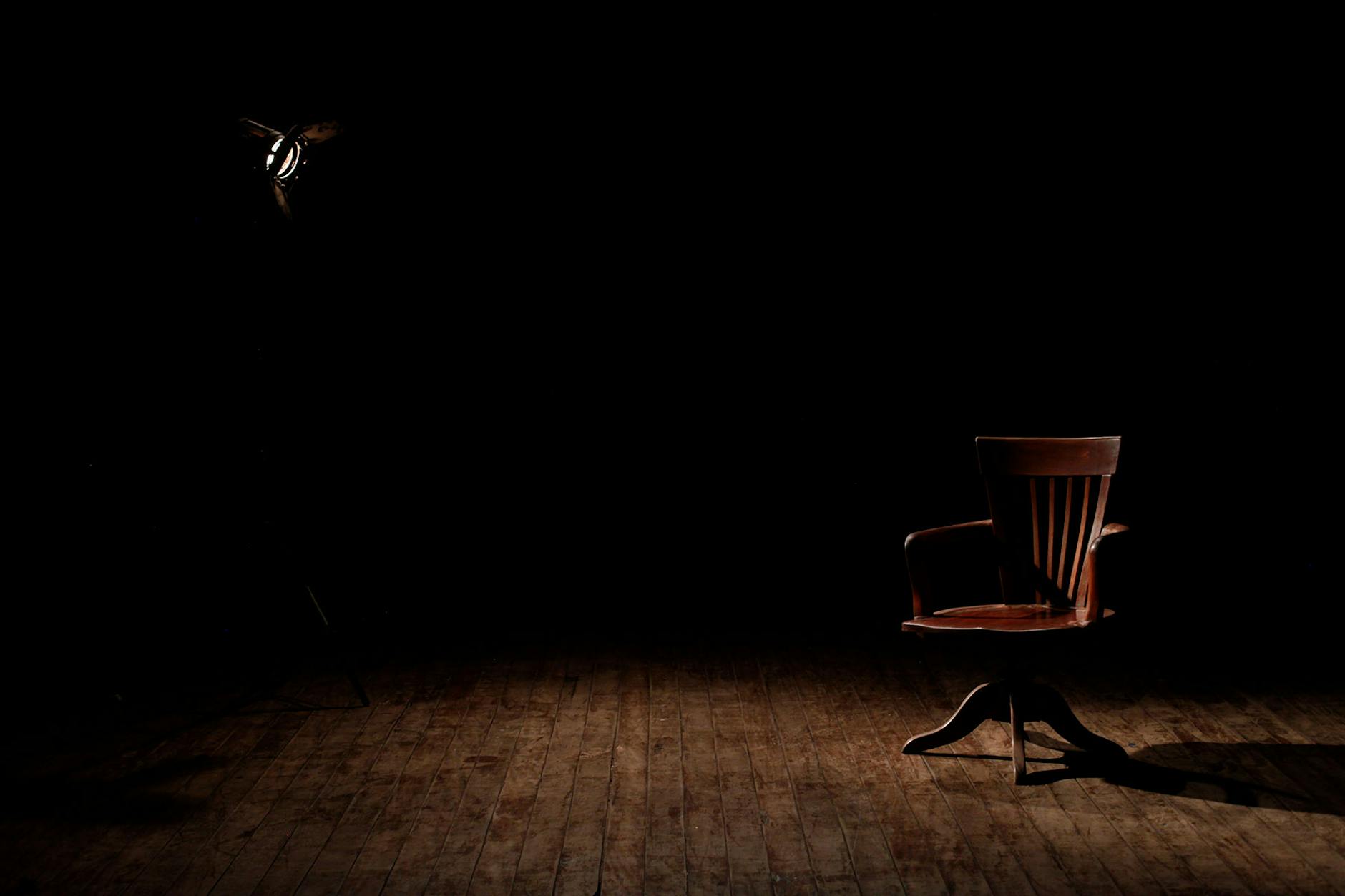Improving the Disclosure of Information in an Investigative Interview: Rapport building and the Physical Environment
When you think about an interrogation room, what do you picture? A small, dull, and anxiety-provoking room? You may be right; some interrogation rooms look like this. However, does the room really matter? Is it possible to influence the interviewee through the physical environment of the interrogation? We explore this topic by discussing the current scientific consensus regarding interrogation approaches, and summarize the available literature on how the physical environment influences the disclosure of information.
 Interrogation rooms can feel dark, lonely, and cramped. Image under CC0 license from www.pexels.com.
Interrogation rooms can feel dark, lonely, and cramped. Image under CC0 license from www.pexels.com.
Have you ever watched those Law & Order episodes in which the suspect of a crime is interrogated in a small, dark, and dull room with a one-way mirror?1 Now think. How would these rooms make you feel? Uncomfortable? Anxious? Ready to confess and get out? Well, they may actually be intended for that purpose. A a widely used interrogation protocol in the United States - the Reid technique – recommends that interrogation rooms be designed to invoke unease and a sense of powerlessness in the suspects. The idea is that feeling uncomfortable makes suspects compliant and willing to confess [1].
However, a room set up to evoke unease and powerlessness could also have the opposite effect, making suspects less cooperative. Think about it – is there anything about being placed in a small, uncomfortable room that would actually make you feel like talking to the police? Legal psychologists have begun to examine this question. Is the physical environment influential during interviews? And can it be used to elicit cooperation and sharing of information (“disclosure”)? This paper will discuss the current scientific consensus regarding interrogation approaches, and summarize the available literature on how the physical environment influences the disclosure of information.
Accusatorial vs. Information-Gathering Interviews
While the Reid technique is still popular in United States [2], over the past decade it has come under increased scrutiny, mostly for its reliance on an accusatorial interview style. This style assumes that the interviewee is guilty, and is aimed towards eliciting confessions. Examples include: appealing to the interviewee’s sense of guilt (e.g., using statements such as “how can you live with such a lie?”), minimization (undermining the crime’s seriousness and diminishing the potential consequences for confessing), and lying about the presence of incriminating evidence (e.g., “we have finger prints and will find out anyway”). Unfortunately, an accusatorial style can lead innocent people to confess to crimes they did not commit. [3]. In the much publicized Central Park jogger case, for example, five juvenile males served between six and 13 years in prison based on confessions that were later proved to be false. Prior to falsely confessing, the juveniles were subject to stressful and severe interrogations lasting between 14 and 30 hours, and were led to believe that they could go home if they confessed [4]
Besides leading to false confessions, accusatorial style interviewing may also sometimes elicit resistance, rather than cooperation [5,6]. Thus, researchers have started advocating for a friendlier, information-gathering style to interviewing. Such a style is not guilt-presumptive and focuses on obtaining full accounts of information, rather than confessions [6,7,8,9]. Take, for example, the recent case of a British man arrested for planning to kidnap and murder a soldier. The man refused to cooperate during his interviews, stating that he would only talk “openly and honestly” to the “right person”. After failing to elicit cooperation from the suspect, a new investigator took charge, using a friendly approach:
“[…] Only you know these things [suspect’s name]. If you are willing, you’ll tell me, and if you’re not, you won’t. I can’t force you to tell me – I don’t want to force you. I’d like you to help me understand. Would you tell me about what happened?”
Faced with this approach, the suspect responded positively: “That is beautiful,” he said. “Because you have treated me with consideration and respect, yes I will tell you now […]” [10].
At the core of the information-gathering approach is relationship building, often referred to as rapport. Building rapport with an interviewer involves three main components: mutual attention, positivity, and coordination. Mutual attention involves displaying interest and involvement to the interviewee. Positivity consists of behaving in a friendly and approachable manner. Coordination refers to the harmony and “in sync” pattern of interaction that the investigator and interviewee develop throughout the interview [11]. Through rapport building, investigators are able to develop a constructive relationship with the interviewee, creating an atmosphere that encourages cooperation and supports the task of obtaining information [12].
Importance of the Environment
Thus, disclosure largely relies on the quality of communication between the interviewee and the investigators. Social psychological research suggests that the environment can also help in creating an atmosphere conducive to obtaining information. When we communicate, aspects of our environmental surroundings influence our behavior, in turn influencing how we interact with each other [13]. For example, we assess our environment in terms of how familiar it is to us; unfamiliar environments can cause us to behave more cautiously towards others. Another dimension relates to perceptions of constraint; how confined or free we feel in our environment can influence our comfort levels. We also assess our environment based on perceptions of warmth; feeling warm (psychologically, not just physically) can help us relax and feel at ease. Other dimensions include perceptions of privacy, formality, and both emotional and physical distance [13]. All of these dimensions are of consequence when interviewees assess their environment during investigative interviews, and can in turn influence the dynamic, the rapport they build with the investigator, as well as their disclosure.
Physical Environment, Comfort, and Disclosure
Although a new area of investigation in the legal field, the influence of the environment on disclosure has been examined in other fields, such as in counseling and health-care settings. Similar to an investigative interview scenario, the disclosure of accurate information from clients is vital for counselors to make appropriate diagnosis [14]. For this reason, a number of health care-related studies examined whether alterations of the environment can influence client disclosure with their counselors [15,16,17]. Some studies have found specific aspects of the interview room setting to influence disclosure, such as room size, with a larger room facilitating the client’s self-disclosure as well as feelings of comfort [18]. Likewise, a smaller physical space has been shown to induce feelings of crowding in clients, inhibiting communication [19]. Moreover, the overall ambience of the interview setting can also influence disclosure. For instance, a study showed disclosure to be substantially higher in a ‘warm’, intimate room compared to a ‘cold’, non-intimate environment [15]. Another study indicated an influence of room décor on interpersonal communication, with a room decorated more home-like (as opposed to office-like) leading to increased communication concerning general and intimate topics [20]. The author attributed this to the prospect that homey décor is not just more physically comfortable, but can also be more psychologically comfortable, inducing a sense of shelter that is associated with home. These studies provide support for the potential influence of both specific environmental factors such as room size, and overall environmental atmosphere on the interviewee’s comfort and self-disclosing behavior during interviews.
Environmental Manipulations and Legal Psychology
Despite the findings noted above, the role of the environment in investigative interviewing received surprisingly little attention. However, Kelly, Miller, Redlich, and Kleinman [21] illustrated the importance of the environment in their taxonomy of interrogation methods (see Figure 2 below). At the heart of the taxonomy is rapport and relationship building, which as aforementioned is a vital component of an information gathering interview. Rapport can be influenced by the other domains, Collaboration (e.g., appealing to sense of cooperation, making bargains with the interviewee), Confrontation/competition (e.g., lying to interviewee, emphasizing authority), Evidence presentation (e.g., presenting false incriminating evidence, reveal evidence that interviewee was unaware the investigator had), and Emotional provocation (e.g., appeal to self-interests of interviewee, instill hopelessness, use flattery).
 Figure 2. Taxonomy model from Kelly, Miller, Redlich, and Kleinman (2013). Reprinted with permission from the author.
Figure 2. Taxonomy model from Kelly, Miller, Redlich, and Kleinman (2013). Reprinted with permission from the author.
Importantly, Kelly and colleagues emphasized the role of context manipulation. In this model, context manipulation refers to the altering of the physical and/or temporal space of the interrogation room, to increase the probability of a successful interview. Examples of contextual manipulations include considering the size of the interview room, the time of day, the seating arrangement, and room temperature [21]. Context manipulation is composed solely of techniques based on non-interpersonal and environmental factors rather than communicative ones. It is, for example, easily imaginable that a pleasantly decorated room leads to increased levels of comfort, which in turn leads to better rapport.
Recently, academics have begun to examine the effects of experimentally changing (“manipulating”) certain aspects of the environment in investigative interview settings. To our knowledge, only two studies2 - reported in Dawson, Hartwig, Brimbal, and Denisenkov [23], have looked at the effects of environmental manipulations in lab-based experiments on disclosure. In both studies participants were interviewed about a staged crime they took part in. Notably, the authors manipulated the size of the interview rooms, with one room twice the size of the other. The larger room was helpful in eliciting disclosure: participants who were interviewed in the larger room provided more critical and overall details regarding the crime. The authors suggested a simple explanation for this; a larger room elicits more comfort and thus fosters a more positive dynamic between the investigator and the interviewee. This is consistent with the previous health care literature on room size and client disclosure. Further, self-reported ratings showed that participants interviewed in the larger room reported wanting to leave less than the ones interviewed in the smaller room. This finding contadicts the Reid technique’s assumption that a smaller room is more efficient for investigative interviewing.
The ongoing study of how the physical environment affects disclosure does not need to be restricted to manipulations of rooms. For example, conducting police interviews in environments outside of the police station entirely may also benefit disclosure. For example, anecdotal data suggests it is common to conduct witness interviews at other locations [e.g., 24]. For example, a senior investigator from The Hague’s Police Unit in the Netherlands stated that when handling uncooperative witnesses, he does not interview them at the station, but rather takes them out for a coffee or meets them at home to instill trust and create rapport with the witnesses:
“[….] First be a friend and after being a friend, start talking. And then convince someone it is very important to talk. So, go to a place where you can have coffee or have lunch. And then you build the relationship, after you can talk to them about the case.” [25].
Another example comes from an investigator of the International Criminal Tribunal for the former Yugoslavia (ICYT). He described a suspect interview taking place in a motel room. The investigator stated that, in conjunction with other techniques, this helped to create rapport, which subsequently led to the suspect’s confession [26].
Concluding Remarks
Just as it does in our personal day-today interactions, the environment exerts an influence on how investigators and interviewees behave and communicate. However, research on these environmental influences has often been overlooked, and the literature in this area is just beginning to expand. Not surprisingly, academics have expressed the need for further exploration in this area [see 27,9]. It would be beneficial for future research to evaluate how the environment can be used to the advantage of the investigator, by making small but well thought-out changes to the physical environment. While such environmental manipulations have often been used to foist unease and powerlessness on the interviewee (i.e., by isolating them or conducting the interrogation in a small room – think about the Law & Order example), this may actually be counter-productive. Instead, environmental manipulations have the potential to facilitate disclosure and rapport building, which are in line with a more effective information-gathering approach. Legal investigators should also continue to draw on insights that have been tested in other fields, such as in health-care research.
Notably, expanding research in this area has promising practical implications, as it can inform practitioners about innovative and simple tactics for facilitating rapport and disclosure, while steering away from problematic accusatorial techniques. As the example from the ICYT officer suggests, it may be beneficial to consider different interview locations as a technique for improving the outcome of the interview. Moreover, conducting interviews in spacious environments or arranging the interview room to appear more ‘warm’ instead of cold and dull, are fairly easy modifications that majority of police departments can implement.
So, think again. If you were being questioned in a police investigation, what kind of environment would encourage you be more cooperative?
References
[1] Inbau FE, Reid JE, Buckley JP, Jayne BC. Criminal interrogation and confessions, 5th edition. Jones & Bartlett Learning; 2013
[2] Kelly CE, Meissner CA. Interrogation and investigative interviewing in the United States: Research and practice. Contemporary developments and practices in investigative interviewing and interrogation. 2015;2.
[3] Meissner CA, Redlich AD, Michael SW, Evans JR, Camilletti CR, Bhatt S, Brandon S. Accusatorial and information-gathering interrogation methods and their effects on true and false confessions: A meta- analytic review. Journal of Experimental Criminology. 2014 Dec 1;10(4):459-86.
[4] Nesterak E. Coerced to Confess: The Psychology of False Confessions. Psych Rep.(Oct. 21, 2014), http://thepsychreport. com/conversations/coerced-to-confess-the-psychology-of-false-confessions.
[5] Kelly CE, Redlich AD, Miller JC. Examining the meso-level domains of the interrogation taxonomy. Psychology, Public Policy, and Law. 2015 May;21(2):179.
[6] Vrij A, Meissner CA, Fisher RP, Kassin SM, Morgan III CA, Kleinman SM. Psychological perspectives on interrogation. Perspectives on Psychological Science. 2017 Nov;12(6):927-55.
[7] Hartwig M, Meissner CA, Semel MD. Human intelligence interviewing and interrogation: Assessing the challenges of developing an ethical, evidence-based approach. InInvestigative Interviewing 2014 (pp. 209-228). Springer, New York, NY.
[8] Evans JR, Meissner CA, Ross AB, Houston KA, Russano MB, Horgan AJ. Obtaining guilty knowledge in human intelligence interrogations: Comparing accusatorial and information-gathering approaches with a novel experimental paradigm. Journal of Applied Research in Memory and Cognition. 2013 Jun 1;2(2):83-8.
[9] Evans JR, Meissner CA, Brandon SE, Russano MB, Kleinman SM. Criminal versus HUMINT interrogations: The importance of psychological science to improving interrogative practice. The Journal of Psychiatry & Law. 2010 Mar;38(1-2):215-49.
[10] Leslie, I. The scientists persuading terrorists to spill their secrets. The Guardian. Retrieved from https://www.theguardian.com/news/2017/oct/13/the-scientists-persuading-terrorists-to-spill-their-secrets. 2017 Oct
[11]Tickle-Degnen L, Rosenthal R. The nature of rapport and its nonverbal correlates. Psychological inquiry. 1990 Oct 1;1(4):285-93. .
[12] Abbe A, Brandon SE. The role of rapport in investigative interviewing: A review. Journal of investigative psychology and offender profiling. 2013 Oct 1;10(3):237-49.
[13] Knapp ML, Hall JA, Horgan TG. Nonverbal communication in human interaction. Cengage Learning; 2013.
[14] Okken V, van Rompay T, Pruyn A. Room to move: On spatial constraints and self-disclosure during intimate conversations. Environment and behavior. 2013 Aug;45(6):737-60.
[15] Chaikin AL, Derlega VJ, Miller SJ. Effects of room environment on self-disclosure in a counseling analogue. Journal of Counseling Psychology. 1976 Sep;23(5):479
[16] Cohen BN, Schwartz RC. Environmental factors and clients' self-disclosure in counseling. Psychological reports. 1997 Dec;81(3):931-4.
[17] Lecomte C, Bernstein BL, Dumont F. Counseling interactions as a function of spatial-environmental conditions. Journal of Counseling Psychology. 1981 Nov;28(6):536.
[17] Okken V, van Rompay T, Pruyn A. Exploring space in the consultation room: Environmental influences during patient–physician interaction. Journal of health communication. 2012 Apr 1;17(4):397-412.
[19] Sundstrom E. An experimental study of crowding: Effects of room size, intrusion, and goal blocking on nonverbal behavior, self-disclosure, and self-reported stress. Journal of Personality and Social Psychology. 1975 Oct;32(4):645.
[20] Gifford R. Light, decor, arousal, comfort and communication. Journal of Environmental Psychology. 1988 Sep 1;8(3):177-89.
[21]Kelly CE, Miller JC, Redlich AD, Kleinman SM. A taxonomy of interrogation methods. Psychology, public policy, and law. 2013 May;19(2):165.
[22] ten Brinke L, Khambatta P, Carney DR. Physically scarce (vs. enriched) environments decrease the ability to tell lies successfully. Journal of experimental psychology: general. 2015 Oct;144(5):982.
[23] Dawson E, Hartwig M, Brimbal L, Denisenkov P. A room with a view: Setting influences information disclosure in investigative interviews. Law and human behavior. 2017 Aug;41(4):333.
[24]Clarke C, Milne R. A national evaluation of the PEACE Investigative Interviewing Course. London: Home Office; 2001.
[25] De la Fuente Vilar, A, Horselenberg, R., van Koppen, PJ. (2017) Interviewing uncooperative witnesses: Practitioner’s perspective. Manuscript in preparation.
[26] O’Brien M, Kebbell M. Interview Techniques in International Criminal Court and Tribunals. InInvestigative Interviewing 2014 (pp. 91-101). Springer, New York, NY.
[27]Meissner CA, Kelly CE, Woestehoff SA. Improving the effectiveness of suspect interrogations. Annual review of law and social science. 2015 Nov 3;11:211-33
Notes
[1] For an of what interrogation rooms can look like, please refer to Richard Ross’ book “Architecture of Authority” (http://richardross.net/architecture-of-authority-c8ac7#_)
[2] A third study, ten Brinke, Khambatta and Carney [22], examined the effects of altering interview room characteristics in legal settings However, as these authors were primarily interested in lie detection accuracy, rather than disclosure.
article author(s)
article keywords
article glossary
- anxiety
- feeling
- cooperation
- guilt
- Accusatorial style
- False confessions
- Information-gathering approach
- building rapport
- warmth
- field
- self-disclosure
- factors
- Taxonomy of interrogation methods
- Collaboration
- Evidence presentation
- Emotional Provocation
- Context Manipulation
- analytic
- paradigm
- Memory
- nonverbal communication
- goal
- arousal




